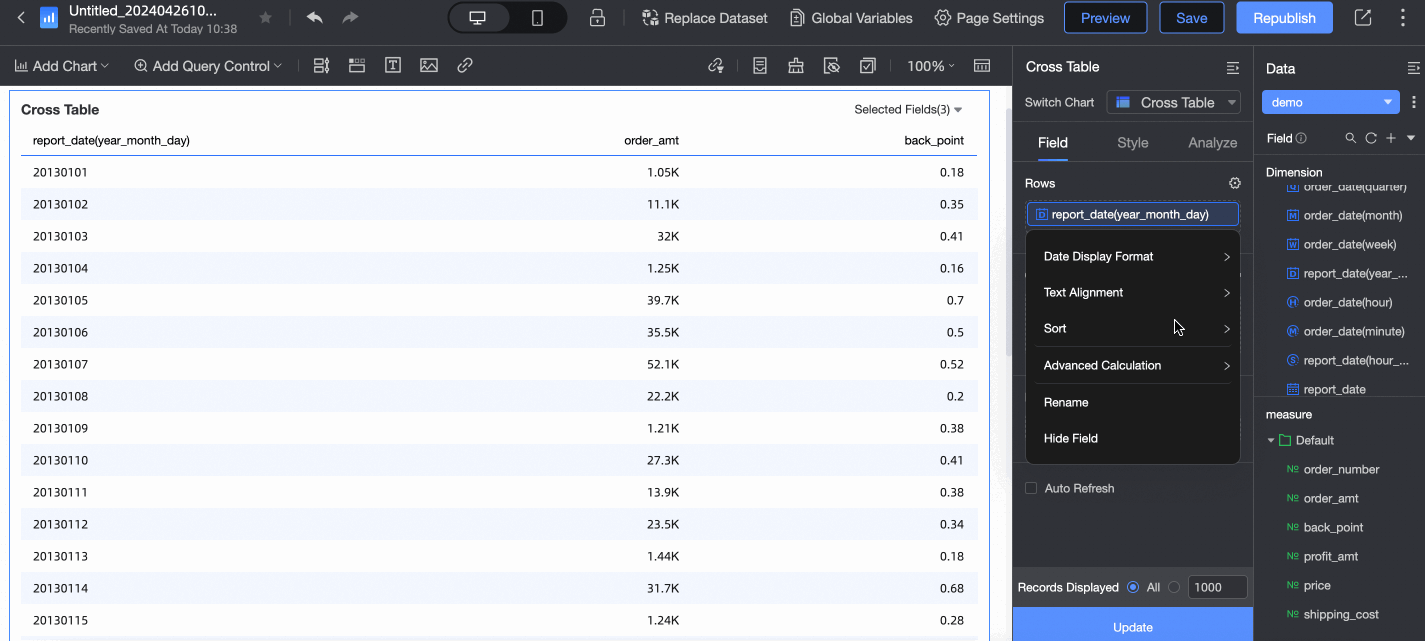This topic introduces the configuration of chart fields, styles, and analysis options within a dashboard.
In the Fields tab of the dashboard editing interface, you can add dimension and measure fields to the dashboard and configure chart styles and analysis settings:
Please note that discrepancies may arise between field types, chart styles, and analysis options due to variations in data source fields and chart types. Refer to the actual environment for accurate settings.
Configure measure data
The following example demonstrates configuring the measure field using the order quantity field:
Hover over the measure field and click the
 icon on the right.
icon on the right.
Tailor the measure field to your business needs:
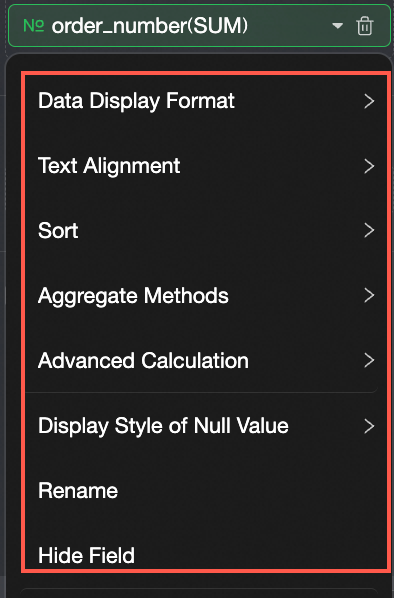
Data display format
Automatic
Integer
1 Decimal Place
2 Decimal Places
Percentage
1 Decimal Place (Percentage)
2 Decimal Places (Percentage)
Custom
Custom formats allow for automatic adaptation, value, percentage, and manual input. For value or percentage types, you can configure the format for negative numbers as -1234 or (1234) and enable Use thousands separator. The specific settings are detailed in the following table:
Format type
Configuration item
Description
Automatic adaptation
Adaptation method
Supports setting Chinese, Traditional Chinese, and English.
Value
Decimal places
Default is none. Supports setting 1, 2, 3, 4, or 5 decimal places.
Magnitude
Default is none. Supports setting thousand, ten thousand, million, ten million, billion, K, M.
Negative number
Supports setting the format of negative numbers to -1234 or (1234).
Use thousands separator
Supports selecting to use thousands separator.
Percentage
Decimal places
Default is none. Supports setting 1, 2, 3, 4, or 5 decimal places.
Negative number
Supports setting the format of negative numbers to -1234 or (1234).
Use thousands separator
Supports selecting to use thousands separator.
Manual input
Adaptation method
Manual input adaptation method, such as #,##0.00%.
Alignment
Horizontal alignment options include Automatic, align left, align center, and align right.
Vertical alignment options include Automatic, align top, align middle, and align bottom.
Sort
Sorting options include No sort, ascending, descending, ascending within group, descending within group, and advanced sort.
Aggregation method
Supported aggregation methods include sum, average, count, remove duplicates, maximum, minimum, median, percentile, population standard deviation, sample standard deviation, population variance, sample variance, start time point, and last time point.
Special aggregation methods "start time point/last time point" are described in the following scenarios:
Start time point/last time point:
For analyzing monthly product order data, to view the amount at the start time point and the end inventory amount for the period, set the aggregation method to start time point or last time point as shown:

When querying the order amount for a specific period using the query control, to view the amount at the start time point and the end inventory amount for the period, set the aggregation method to start time point or last time point as shown:
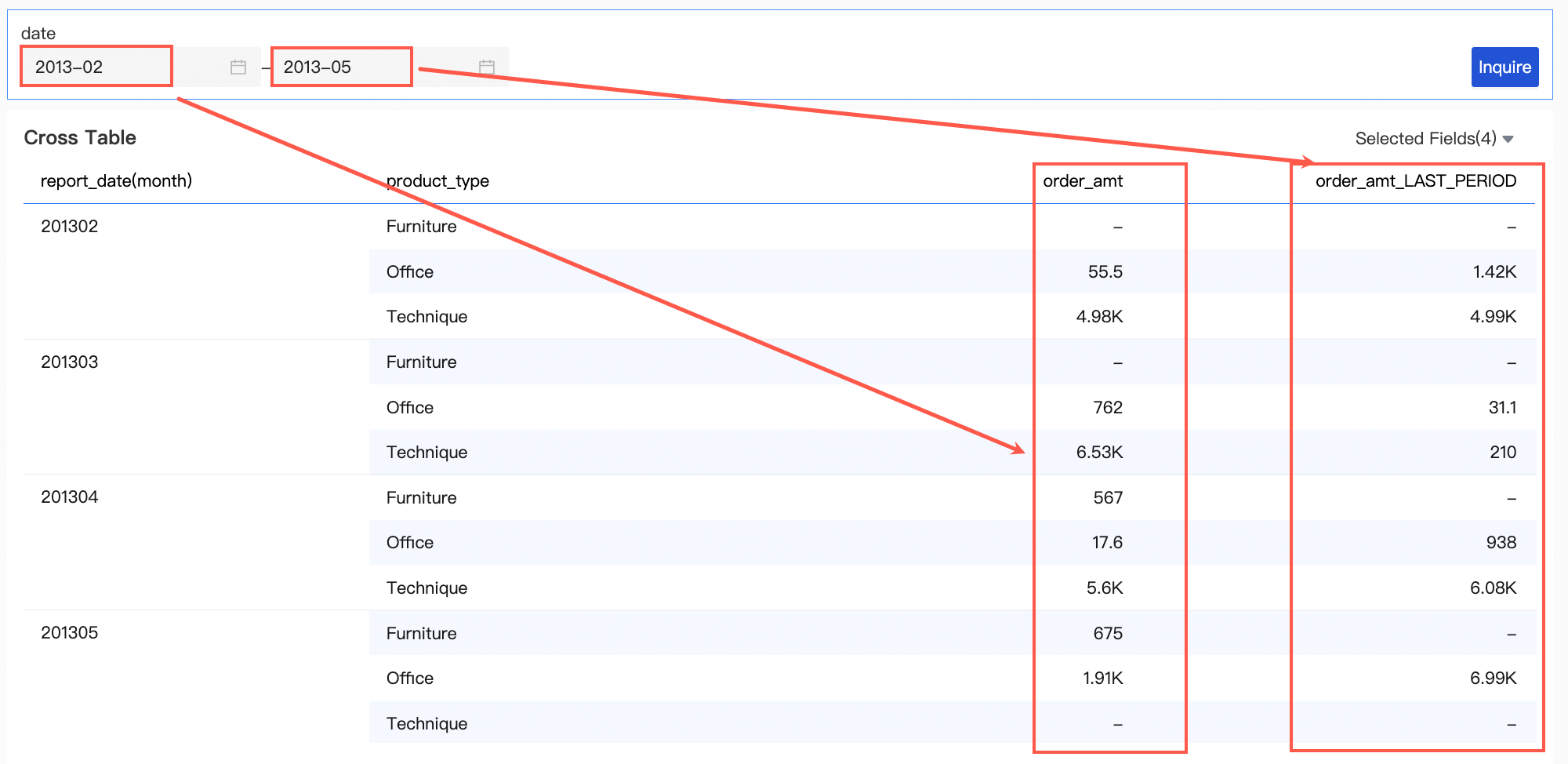
For analyzing inventory quantity of different product types in each area, to view the inventory quantity at the final order time point, set the aggregation method to last time point as shown:
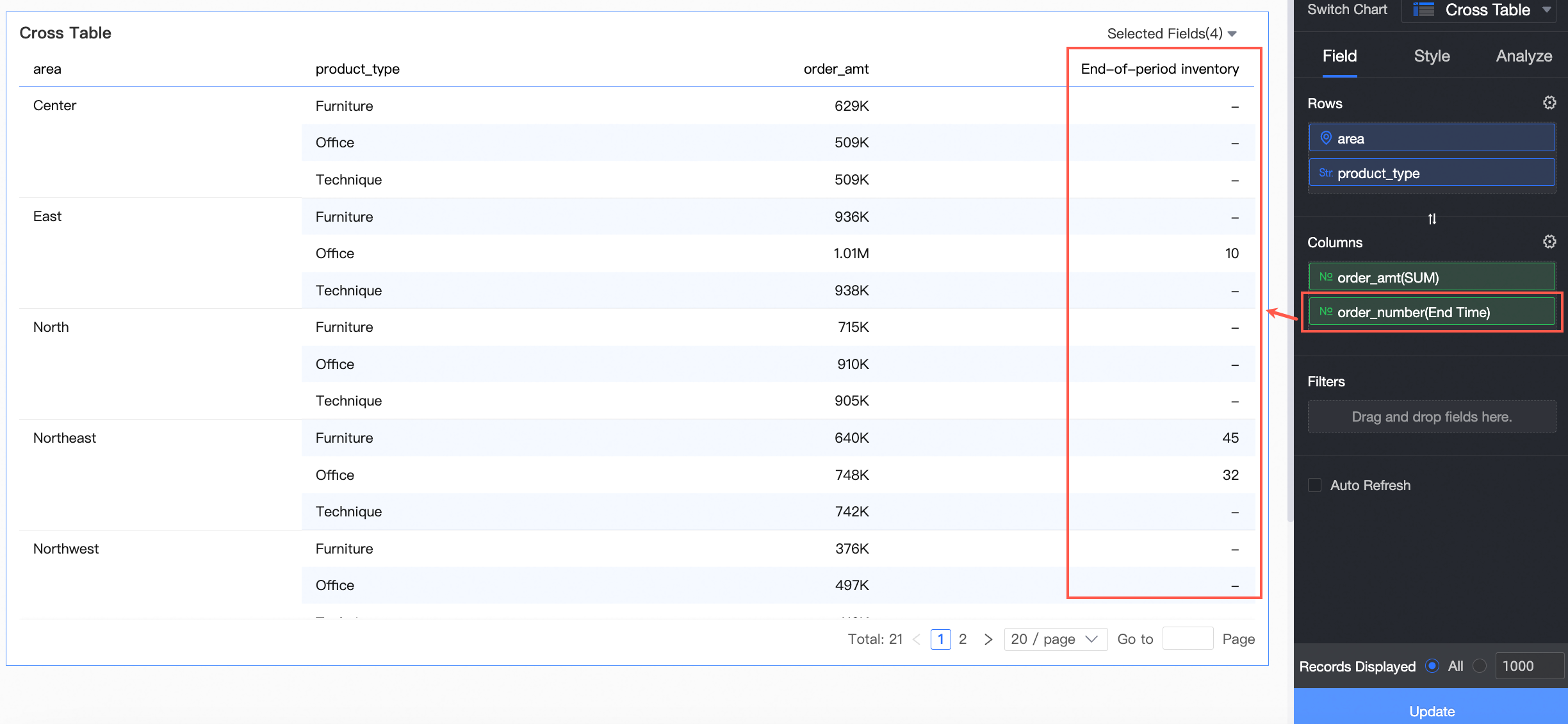
The following table describes the aggregation methods supported by different data source types:
Data Source
Aggregation Method
All data sources compatible with Quick BI
Sum, average, count, remove duplicates, maximum, minimum, start time point, last time point.
MySQL, Vertica, SAP IQ (Sybase IQ), SQL Server, Presto, Alibaba PolarDB for Oracle, PostgreSQL, Oracle, MaxCompute, Hive, SAP HANA, AnalyticDB for PostgreSQL, Gbase, IBM DB2 LUW, Clivia, ClickHouse, AnalyticDB for MySQL 2.0
Population standard deviation, sample standard deviation, population variance, sample variance
SAP IQ (Sybase IQ), Oracle, MaxCompute, SAP HANA, IBM DB2 LUW
Median
SAP IQ (Sybase IQ), Oracle, MaxCompute, SAP HANA, IBM DB2 LUW
Percentile
Advanced calculation
Date accumulation refers to the sum of data from the initial date to the current date. For more information, see Date accumulation.
Cumulative calculation performs sequential summation on the results returned from the database, providing a clear view of the measure indicators' growth. For more information, see Cumulative calculation.
NoteThe Comparison feature is not configured on the measure field.
Only fields with sum indicators (
 ) support configuring cumulative calculation.
) support configuring cumulative calculation.Cumulative calculation is supported only when the dimension contains one date field and the time granularity of the date field is year, quarter, month, week, or day.
Percentage
% of Grand Total
% of Column Grand Total
% of Row Grand Total
% of Parent Column Grand Total
% of Parent Row Grand Total
Only cross tables support the percentage feature. For more information, see New cross table.
Ranking
Ascending
Descending
Ascending within group
Descending within group
None
For more information, see Data ranking.
TopN
TopN (quick filter) filters the results returned from the database based on value size, enabling users to quickly select the largest or smallest data points.
For more information, see TopN.
Percentile
Percentile calculation ranks the results returned from the database, allowing users to understand the position of specific data within the entire dataset.
For more information, see Percentile.
Comparison
The value changes with the dimension field. For more information, see Configure the Comparison Feature.
None
Empty value display style
Configure the display style for empty values.
Field display content
Set the display name and description for the field.
Hide field
Selecting 'hide field' will remove the field from the report, but you can cancel hide if needed.

Delete field
Hover over the measure field and click the
 icon on the right to delete it.
icon on the right to delete it.
Configure dimension data
Text field
The following example illustrates configuring the dimension field using the product type field:
Hover over the dimension field and click the
 icon on the right.
icon on the right.
Customize the dimension field according to your business requirements:
Alignment
Horizontal alignment options include Automatic, align left, align center, and align right.
Vertical alignment options include Automatic, align top, align middle, and align bottom.
Sort
Sorting options include No sort, ascending, descending, ascending within group, descending within group, custom, field sort, and advanced sort.
Select Custom to drag a field to a specified area.
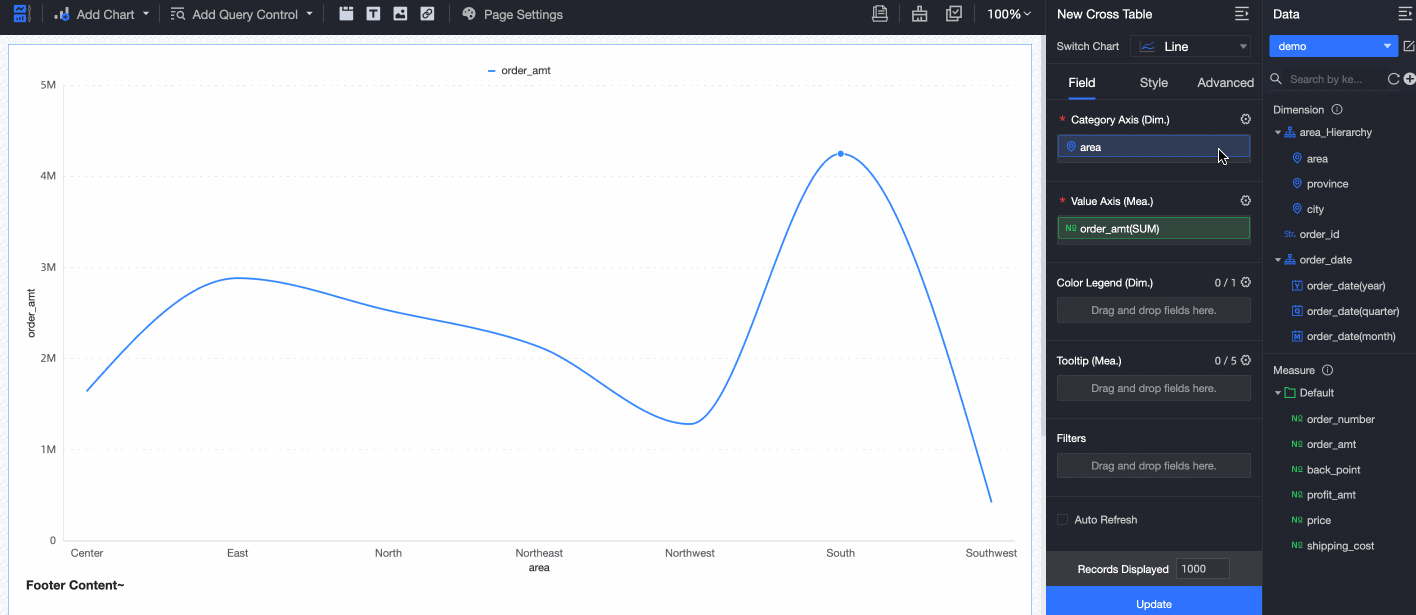
Advanced calculation
Options include None and TopN.
For more information, see TopN.
Empty value display style
Configure the display style for empty values or empty strings.
Empty Value:
Display as '-'
String:
Display as '-'
Field display content
Set the display name and description for the field.
Hide field
Selecting 'hide field' will remove the field from the report, but you can cancel hide if needed.
Drill down into the dimension field.
Hover over the dimension field and click the
 icon on the right.
icon on the right.Delete the dimension field.
Hover over the dimension field and click the
 icon on the right to remove it.
icon on the right to remove it.
Date type field
For fields of the date type, you can configure the Date Display Format in addition to the dimension field settings. This example uses the order date (day) field:
Hover over the dimension field and set the date display format as shown in the figure below.
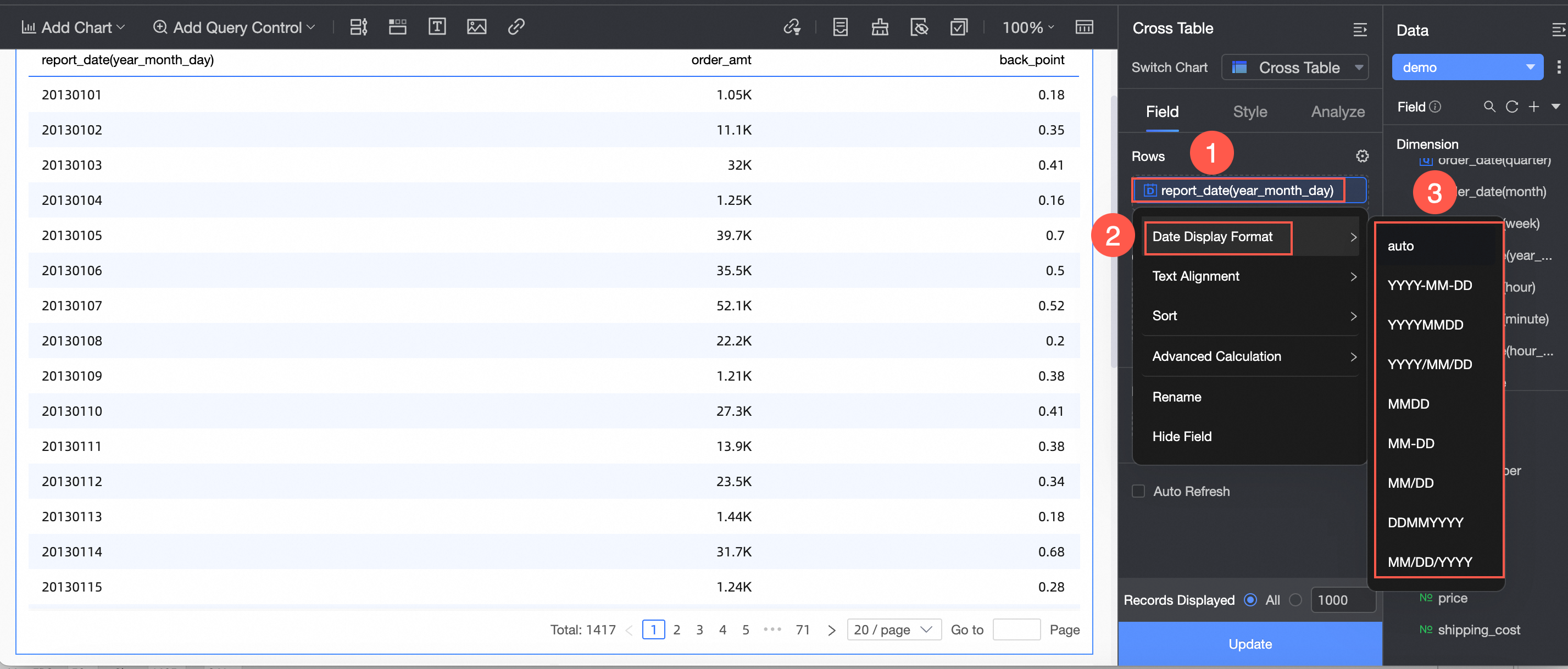
Configuration Effect
